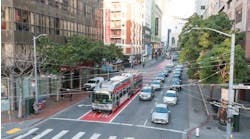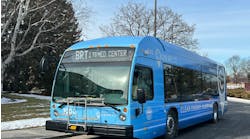More than 40 percent of transit vehicles across the United States are now running on alternative fuel according to the American Public Transportation Association (APTA).
The United States public transportation industry has undergone a major vehicle transformation over the past decade as a result of municipal agencies setting ambitious emissions reduction standards for the benefit of the communities they serve. From compressed natural gas (CNG), liquefied natural gas (LNG), biodiesel, hydrogen, and propane autogas buses, to hybrid-electric and all-electric buses, more than 40 percent of transit vehicles across the country are now running on alternative fuel vehicles (AFVs) according to the American Public Transportation Association (APTA).
What are the benefits of deploying alternative fueled vehicles?
Despite recent oil price reductions, transit agencies throughout the nation are continuing to diversify their fleets with alternative fuels and efficiency technologies. While the fuel cost savings margins are temporarily slimmer than normal, implementing technologies that reduce diesel consumption can provide long-term fuel price stability, improved rider and driver experiences, lower maintenance costs, and decreased vehicle emissions.
The emissions reduction benefits are particularly important as the U.S. EPA expects to finalize its new National Ambient Air Quality Standards (NAAQS) this fall, setting a lower bar on ground-level ozone (a key component of smog) allowed in U.S. communities. With the national ozone standard expected to decrease from 75 ppm to 65 or 70 ppm, a large number of major metropolitan areas are expected to then fall from attainment status into non-attainment. Cleaner alternative fuel vehicles and advanced transportation technologies will become an increasingly important part of the solution.
A number of municipal fleets have already been preparing for the continually tightening regulations by deploying alternative fuel buses, including:
- Dallas Area Rapid Transit (DART) - After an extensive study, DART opted to switch their fleet of 650 buses from diesel and LNG to CNG. President and Executive Director Gary Thomas explained that the decision to convert DART’s fleet was a “no-brainer” as CNG promotes cleaner air while saving taxpayers an estimated $120 million in fuel costs over a 10-year period. Partnering with Clean Energy, DART was able to successfully build and operate public-access CNG stations across the North Central Texas region.
- Dallas County Schools (DCS) - Home to the largest propane school bus fleet in Texas, DCS is saving an estimated $1.5 million in fuel costs annually through the use of 560 propane buses. The district operates more than 1,000 additional buses that are mostly powered by 20 percent biodiesel (B20) engines, furthering its efforts to reduce fuel costs and emissions. DCS produces its B20 onsite by combining its diesel fuel with B100 that it produces from Waste Vegetable Oil (WVO).
- Transit Authority of River City (TARC) – The transit agency for Louisville, Kentucky, and southern Indiana, has been focused on greening its fleet of 250+ buses for several years. TARC’s fleet, which is primarily composed of clean diesel buses with a small number of hybrid-electric and all-electric buses, is set to receive funding to deploy five additional Proterra battery-electric buses and a fast charging station. The zero-emission buses will increase TARC’s fleet of battery-electric buses, and the charger will work with TARC’s existing chargers to expand the area that the battery-electric buses serve.
As the nation continues to make incredible strides in addressing our climate change and air quality concerns, ample funding opportunities—at the federal, local and state levels — are available to assist transit fleets with their investments in lower emission, lower carbon, and lower cost fuels and technologies. As an example, the Federal Transit Administration (FTA) in February allotted $55 million in grants to 10 transit agencies to deploy US-made electric transit buses.
How do you know which fuel is right for your transit operation?
There isn’t a “one-size-fits-all” solution when it comes to alternative fuel vehicles. Transit agencies considering the switch should analyze the best options based on their own routes and logistics, refueling accessibility, grant funding, maintenance costs, and more.
Sean Turner is chief operating officer of Gladstein, Neandross & Associates (GNA), the clean transportation and energy consulting firm that organizes the Alternative Clean Transportation (ACT) Expo.



